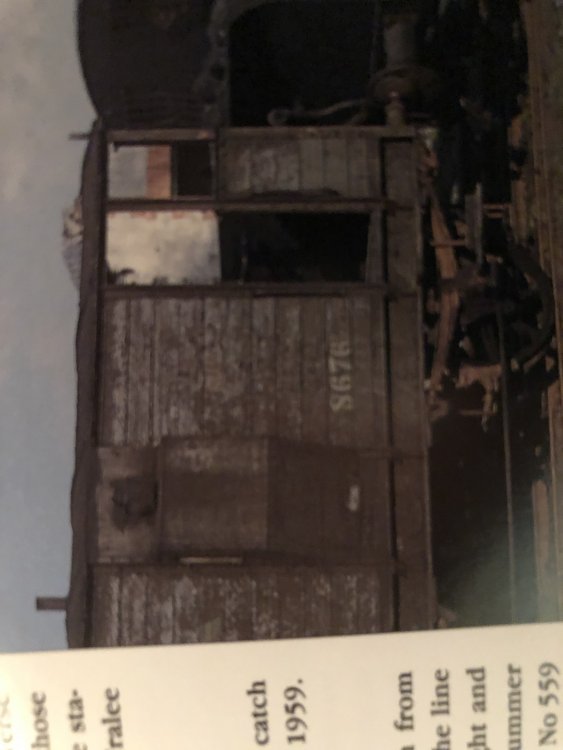-
Posts
15,866 -
Joined
-
Last visited
-
Days Won
393
Content Type
Profiles
Forums
Events
Gallery
Everything posted by jhb171achill
-
A very nice and well-made model!
-
Bord na Mona Andrew Barclay 0-4-0WT in 009
jhb171achill replied to irishrail201's topic in Irish Models
I stand corrected; buffer beams WERE red, on the front anyway....- 5 replies
-
- 009
- narrow gauge
-
(and 2 more)
Tagged with:
-
I’ve one or two more somewhere...... He had an ordinary first class return from Tralee to Dingle, which I think his father used, as he always said he did the T & D (and the Schull & Skib) only once. While in that area, he did the whole West Cork, including two trips to Macroom (one in the cab and one in a brake van); though he missed the two Cork narrow gauge lines.
-
I know it’s s different van, Leslie, it was just to show the awful state they got into! (And the new silver locomotives didn’t take long to match them....!)
-
Ah yes! A truly superb job it was too.
-
The six wheeled coach - is that a SSM one?
-
.....in which case the food chain has even less use for the driver. Bring on the double headed 201s!
-
Couldn't believe this deliberate act. A pity a stray 201 wasn't coming along - we don't need retards like this in the food chain......
-
I’m getting two....... not going to miss the opportunity!
-
I will ask Barry Carse. He knows of the procedures there.
-
Ah, yes, that's when it was going to Whitehead! It had been repainted for that.
- 59 replies
-
- cie
- supertrain
-
(and 1 more)
Tagged with:
-
That's got a lot of potential to be a very nice little operation!
-
Shabby grey J15s (and a few Midland gems from Mayner) and BnT 141s will also be the order of the day at Dugort Harbour, which takes shape as we speak in the workshop of Baseboard Dave. I have one black "C", though I'm on the lookout for a decent green one too.
-
For those who never saw them, it's also worth pointing out that the black roofs were a very late addition, long after the post-1987 "tippex" stripes were added. the above pic is of one fairly newly repainted when it was taken.
- 59 replies
-
- cie
- supertrain
-
(and 1 more)
Tagged with:
-
Excellent!!!! So no class 08 shunters, James the engine of colour, or Flying Scotsmen either!
-
When new, the grilles on the genny vans were not all black as on the model. The orange / tan continued across them top and bottom.
- 59 replies
-
- cie
- supertrain
-
(and 1 more)
Tagged with:
-
That's looking REALLY nice! One thing though - it's seems common to see these tapered end platforms on many layouts. I know they're standard Hornby stuff, but tapered platform ends were almost unknown not only in Ireland but anywhere else, with the sole exception of where travels were converging either side. The only example I can think of in Ireland is the south end of the Loop Junction Platform (still extant, of course) at Downpatrick.
-
BCDR! Though he footplated Great Vic St - Newcastle via Banbridge too, and also travelled on the lifting train from Banbridge to Knockmore Junction..... He footplated the entire BCDR twice, I think 1938 and 1944 or something like that.
-
This is the state that many older wagons, ex-GSW stuff included, managed to get into by the late 1950s....
-
Bord na Mona Andrew Barclay 0-4-0WT in 009
jhb171achill replied to irishrail201's topic in Irish Models
Lovely little loco! I’d love to see a steam BnM layout; I could never get those tractors! Your model is very similar to a BnM one. Imagine all three! Livery wise, all the above needs is a repaint into a very much darker olivey-shaded green - very dark indeed. Lining was a single yellow line and the number was a small shaded gold transfer. I am not 100% on this, but I think that originally the buffer beams might have been black rather than red.- 5 replies
-
- 009
- narrow gauge
-
(and 2 more)
Tagged with:
-
It would be good to see a transfer made of the stencilled flying snail for wagons. In the 1956-onwards period, this was the norm on “snailed” wagons.
-
They could. Certainly Cork to Bandon anyway, and a Luas from Ballincollig into the city and in out towards the airport / Douglas area. Senior had relatives near Birr - and knowing him, cycling there from Birdhill wouldn’t surprise me at all, as he would sometimes cycle from Ranelagh to Liffey Junction or Inchicore, or occasionally to Clondalkin. On one occasion he got the train from Amiens St (having cycled there from Ballsbridge!), to Goraghwood, and thence to Warrenpoint. Then he cycled through Rostrevor, Annalong and Kilkeel to Newcastle. Then he threw the bike in the guards van and footplated an 0.6.0 to Belfast!
-
Good pulling diesel locomotives
jhb171achill replied to joe123's question in DCC, Electrics and Electronics
Any of them would, Joe. I'm presuming you mean on the level? Obviously, gradients affect it; steeper gradients, less wagons, with any loco. -
How did you do the excellently realistic concrete posts holding the station sign?
.png.c363cdf5c3fb7955cd92a55eb6dbbae0.png)



